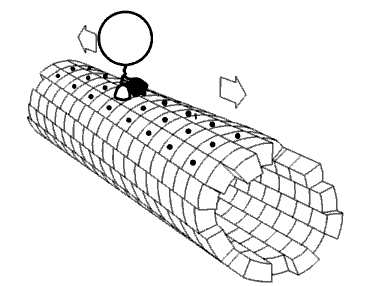
Photo from academic.microsoft.com
Hemoglobin functions as a tetrameric oxygen transport protein, with each subunit containing a heme cofactor. Its denaturation, either in vivo or in vitro, involves autoxidation to methemoglobin, followed by cofactor loss and… Click to show full abstract
Hemoglobin functions as a tetrameric oxygen transport protein, with each subunit containing a heme cofactor. Its denaturation, either in vivo or in vitro, involves autoxidation to methemoglobin, followed by cofactor loss and globin unfolding. We have proposed a global disassembly scheme for human methemoglobin, linking hemin (ferric protoporphyrin IX) disassociation and apoprotein unfolding pathways. The model is based on the evaluation of circular dichroism and visible absorbance measurements of guanidine-hydrochloride-induced disassembly of methemoglobin and previous measurements of apohemoglobin unfolding. The populations of holointermediates and equilibrium disassembly parameters were estimated quantitatively for adult and fetal hemoglobins. The key stages are characterized by hexacoordinated hemichrome intermediates, which are important for preventing hemin disassociation from partially unfolded, molten globular species during early disassembly and late-stage assembly events. Both unfolding experiments and independent small angle x-ray scattering measurements demonstrate that heme disassociation leads to the loss of tetrameric structural integrity. Our model predicts that after autoxidation, dimeric and monomeric hemichrome intermediates occur along the disassembly pathway inside red cells, where the hemoglobin concentration is very high. This prediction suggests why misassembled hemoglobins often get trapped as hemichromes that accumulate into insoluble Heinz bodies in the red cells of patients with unstable hemoglobinopathies. These Heinz bodies become deposited on the cell membranes and can lead to hemolysis. Alternatively, when acellular hemoglobin is diluted into blood plasma after red cell lysis, the disassembly pathway appears to be dominated by early hemin disassociation events, which leads to the generation of higher fractions of unfolded apo subunits and free hemin, which are known to damage the integrity of blood vessel walls. Thus, our model provides explanations of the pathophysiology of hemoglobinopathies and other disease states associated with unstable globins and red cell lysis and also insights into the factors governing hemoglobin assembly during erythropoiesis.
Journal Title: Biophysical journal
Year Published: 2020
Link to full text (if available)
Share on Social Media: Sign Up to like & get
recommendations!